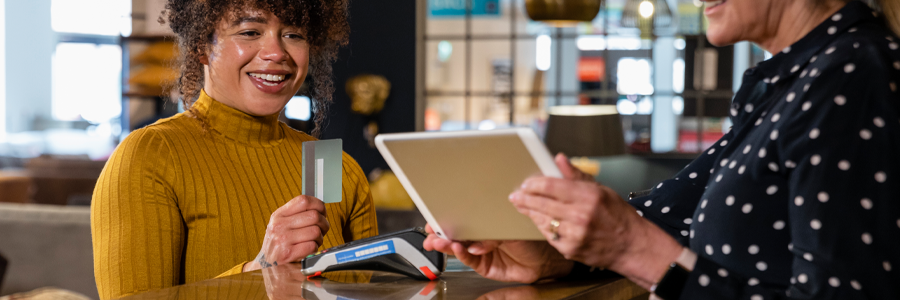
In the SOTI retail industry report, The Tech Effect: Strengthening the Omnichannel to Meet Consumer Demands, consumers defined what is important to them: product pricing, delivery times and product availability.
Although those items are important, retailers are falling behind when it comes to providing them. According to the report, consumers say:
- Goods were more expensive in 2022 vs. 2021 (58%)
- Delivery times were slower than usual (31%)
- Products haven’t been available to purchase (34%)
These issues can be attributed to the supply chain crisis (empty shelves caused by supply chain challenges cost U.S. retailers $82 billion USD), labor shortages (leading up to the busy holiday shopping season in the U.S., there were 5.5 million job vacancies in retail) or a lack of truck drivers (Canada is currently short 30,000 drivers).
All consumers – and therefore all retailers – are dealing with higher prices, longer delivery times and item unavailability. If all things are equal across the board, where do differentiation and value come from? If retailers X and Y are charging the same price for the same item with the same delivery time, what prompts a consumer to choose one over the other?
The answer is personalization.
What is Personalization?
Simply put, personalization is when retailers give consumers a shopping experience that’s uniquely theirs.
For example, personalization occurs when consumers are offered more choice over how they shop and check-out. Or when information regarding the status of their purchases is provided. Or when more control and selection over how they receive items is offered.
Personalization leads to differentiation, and that’s where consumers find value. If two retailers are offering the same item for $100 with the same delivery times, but one retailer lets you track your purchase as it makes its way to your front door and the other one does not, the value – the personalized shopping experience – can be found with the retailer offering more.
DOWNLOAD THE REPORT
Get Your FREE Copy of The Tech Effect: Strengthening the Omnichannel to Meet Consumer DemandsDeliver Value by Creating Personalized Shopping Experiences
As per the SOTI retail industry report, 50% of consumers prefer to shop with retailers that provide a personalized experience – from start to finish, both online and in-person.
This largely stems from the surge in online shopping during the COVID-19 pandemic. In Canada, for example, while many stores were closed, 82% of Canadians shopped online. In Australia, 2.5 million people shopped online for the first time, while 81% of French Internet users made online shopping a new habit.
For many first-time or seasoned online shoppers, personalization options are part of the appeal. Consumers now have choices regarding factors like delivery options. They now have access to real-time information on product availability and can track orders in real-time.
In The Tech Effect: Strengthening the Omnichannel to Meet Consumer Demands, 57% of global consumers say they'll shop in store and continue to take purchases with them while 45% prefer to shop online rather than in store. But what’s consistent across both categories is that people want more personalization. Also from the retail industry report:
- Whether consumers are buying online, in-store or through a combination of buy online pick up in-store (BOPIS), been a 10% increase in the importance of having multiple delivery options to choose from
- 44% are more likely to shop with retailers offering sustainable delivery options or recyclable packaging and 54% will shop with retailers with sustainable return options
- 70% of consumers state delivery time and speed are important factors when making a purchase decision and 61% choose to shop with brands that deliver goods the fastest
- 66% of shoppers expect to know where their deliveries are at all times
When things are the same among retailers for delivery times, product availability and product pricing, personalization will win the day – and dollars – of consumers. When shopping experiences are personalized, consumers are 110% more likely to add additional items to their shopping carts and 40% more likely to spend more than they had planned.
It makes sense for retailers to invest in personalization. The easiest and fastest way to do that is by using existing technology.
Consumers Want Technology While Shopping
Whether consumers are shopping online, in-store or through the omnichannel, they want to incorporate technology into their shopping experiences. What does that mean, exactly? What type of technology do they want to use?
Breaking it down by channel might be the best way to answer this question.
Online
It’s noted in The Tech Effect: Strengthening the Omnichannel to Meet Consumer Demands that consumers use what can be considered “traditional” methods while shopping online:
- 51% shop via a retailer’s website
- 33% shop via a retailer’s app
- 16% shop via a retailer’s social media channels
Personalization occurs when there’s a connected chain of information throughout the process. Once a consumer makes an online purchase, they want to know the moment it’s on the delivery truck. They want to know if there are going to be any delays in shipping and how long they’ll be.
Personalization is about choice, too. Would the consumer pay extra for delivery if it was provided by an electric vehicle (remember, 44% of consumers will shop with retailers who provide sustainable delivery)? Can you deliver to a designated drop-off point (something 61% of consumers have asked for)?
In-Store
Steve Jobs famously said, “Our job is to figure out what they’re [consumers] going to want before they do”, and the fact that 90% of customers expect organizations to know their interests and anticipate their needs, backs up that statement.
Providing targeted offers (favored by 62% of consumers) and coupons (67%) based on past purchases when consumers enter a store is a great way to provide personalization.
- 24% of consumers say if retailers provided mobile devices upon entry, it would result in a better in-store experience
- 31% would like to bypass the cash register altogether and use anytime, anywhere checkout
- 41% of consumers would use smart shopping carts that automatically detect and tally items as they’re placed inside it.
In-store, consumers want more information than just product pricing and more control than simply putting products in a shopping cart. They want to be able to choose delivery options; as per SOTI’s report, 53% of consumers would like autonomous vehicles to deliver larger packages take home themselves. Perhaps consumers know what items they want to purchase and would like a tailored experience to get them in and out of the store as quickly as possible.
Create Personalization to Create Value Across All Channels
Omnichannel shopping is like a relay race: the baton of a personalized experience must be passed from one channel to another as seamlessly as possible.
With the help of the right technology, retailers can keep up with continuously evolving consumer demands both online and in-store. When consumers feel like their unique needs are being met across all touchpoints, brand loyalty is formed. That’s the moment when consumers feel like they’re getting value for their money.
The omnichannel shopping model is here to stay, so retailers must ensure communication, connectivity and flexibility is present throughout the entire experience.



